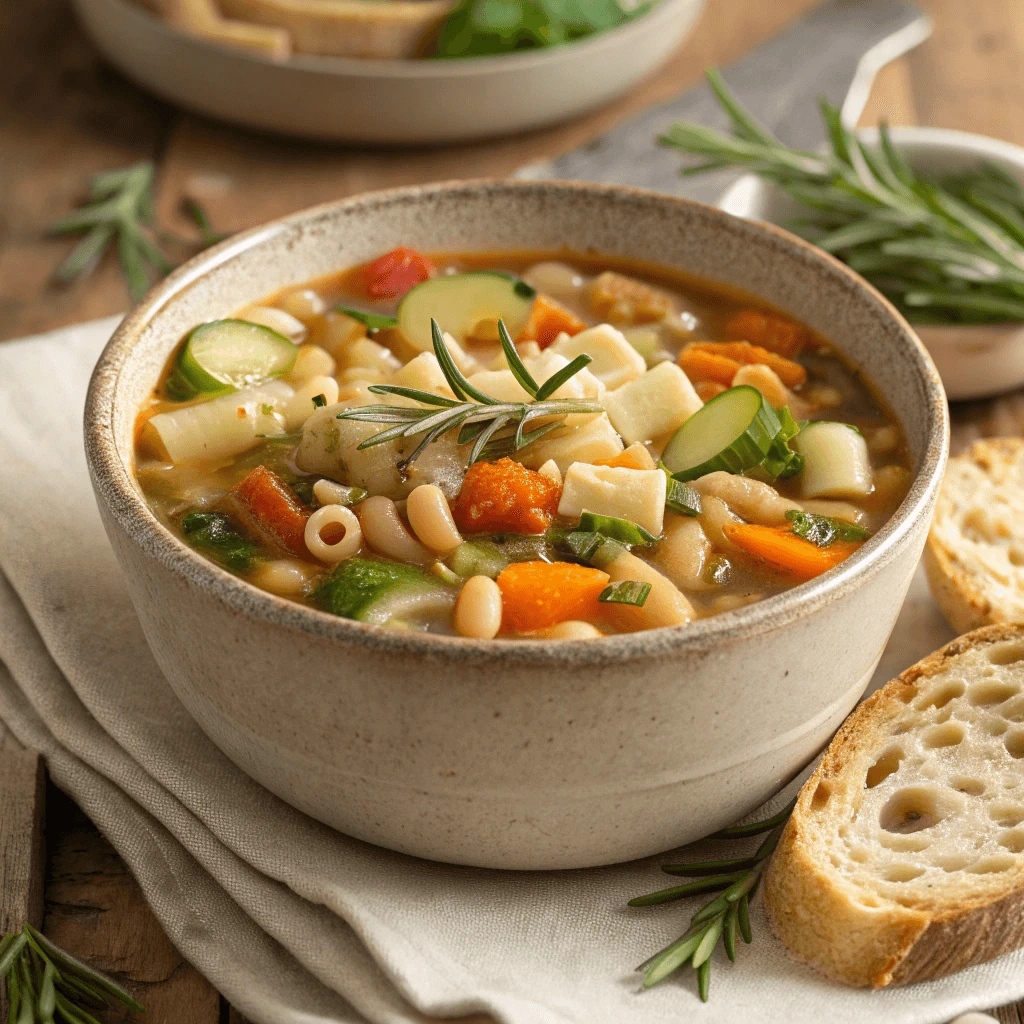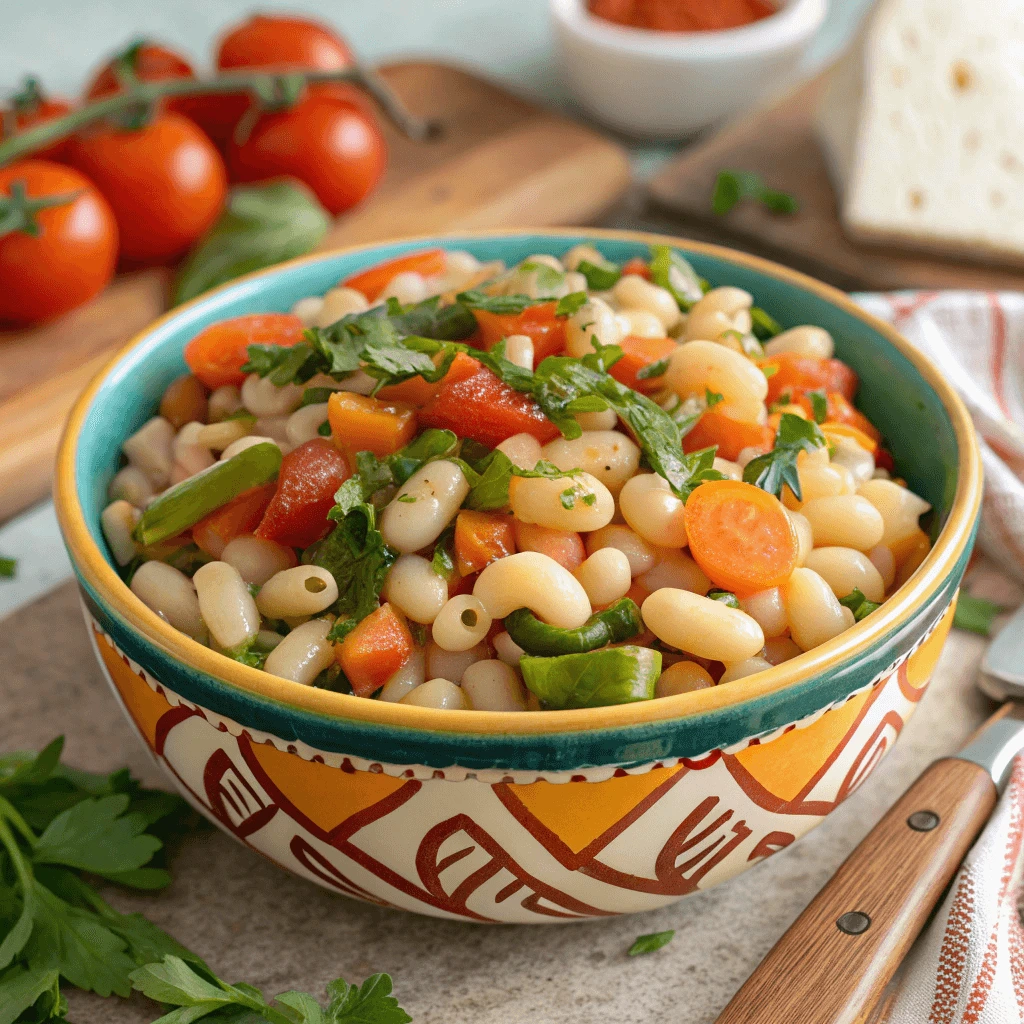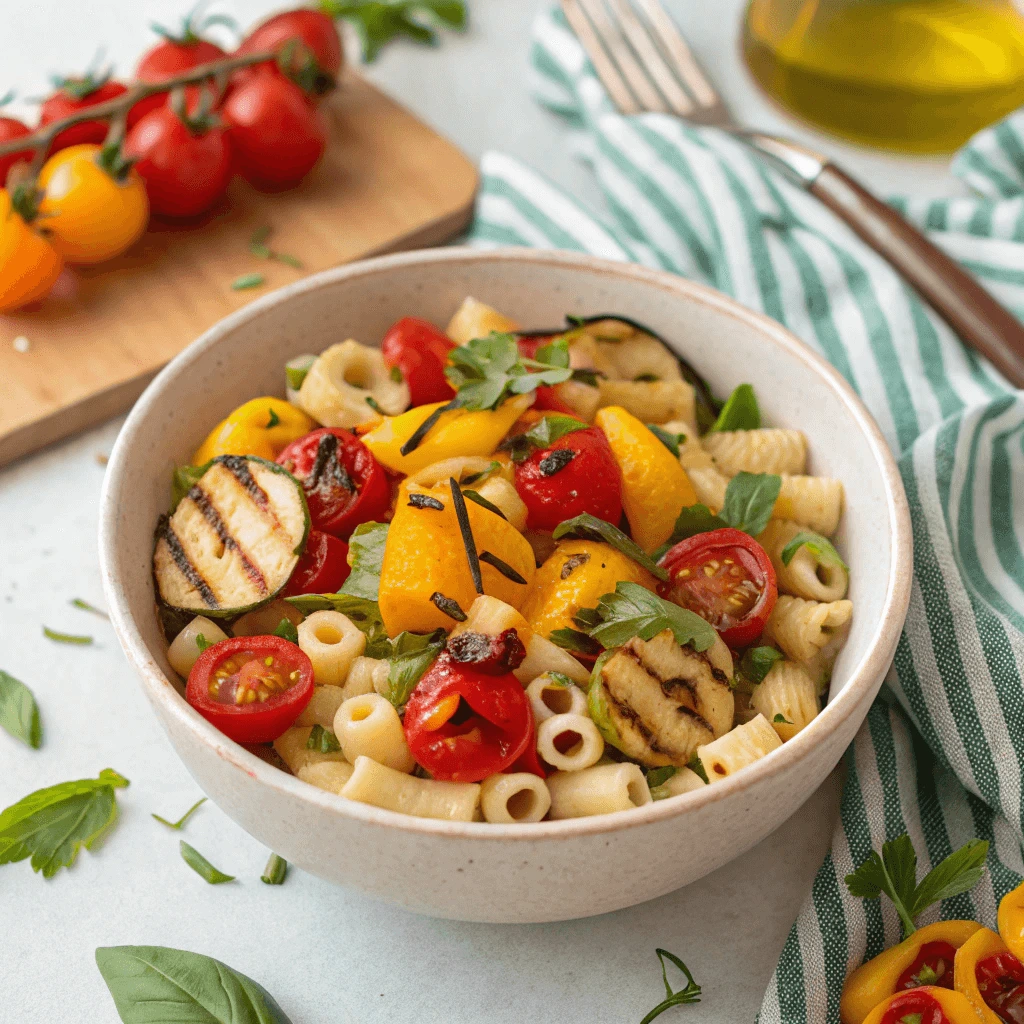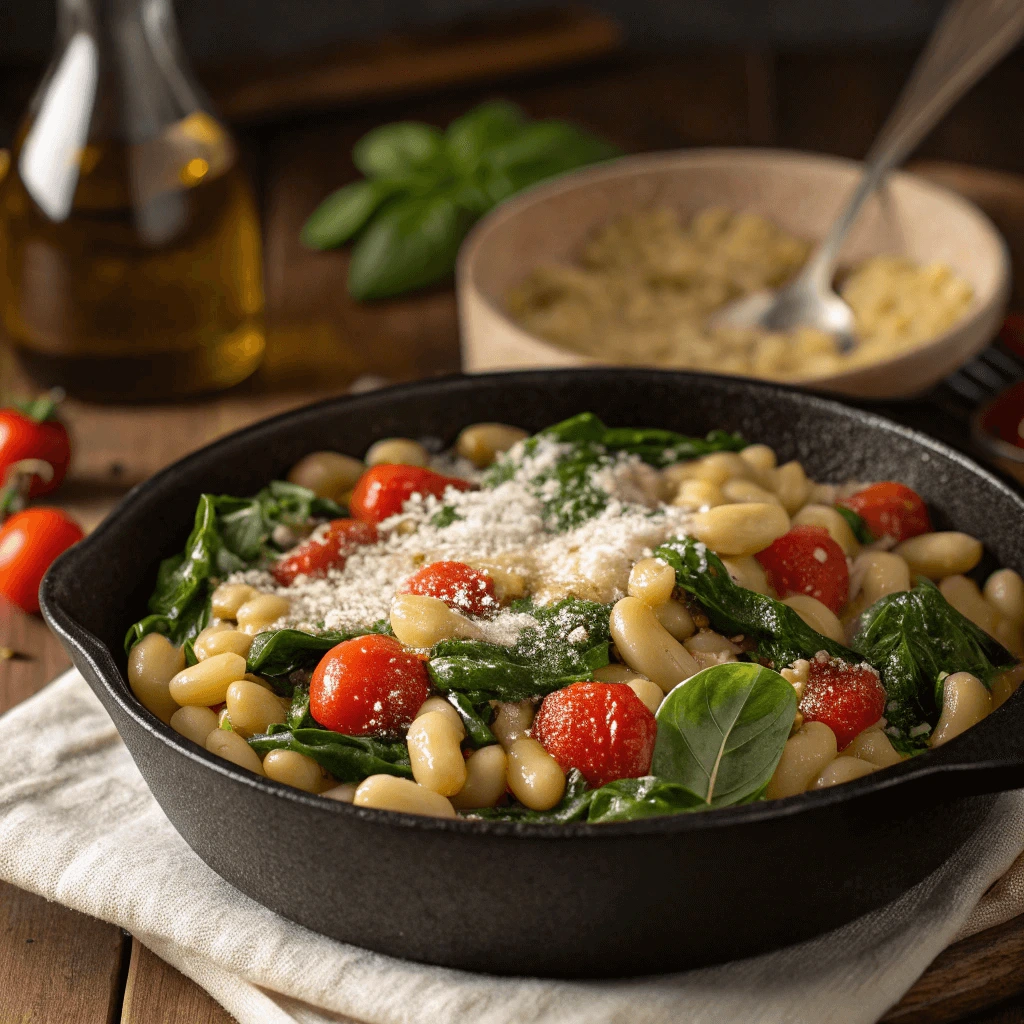Looking for new ways to enjoy pasta? Ditalini pasta recipes are a fantastic choice, offering a versatile base for a wide range of dishes. From hearty soups to fresh salads, Ditalini pasta pairs perfectly with vegetables, beans, and flavorful seasonings. Whether you’re cooking a quick weeknight meal or preparing a comforting dish for family and friends, these Ditalini pasta recipes will provide plenty of inspiration. Read on to discover how you can elevate your pasta dishes with these simple, yet delicious ingredients.
Why Ditalini Pasta Is Perfect for Vegetable and Bean Recipes

What Is Ditalini Pasta?
Ditalini pasta recipes is a small, tube-shaped pasta that originated in southern Italy. The word ditalini translates to “little thimbles” in Italian, which perfectly describes its short, cylindrical shape. It’s slightly larger than pastina but smaller than elbow macaroni, making it ideal for holding onto sauces, broths, and small bits of vegetables or beans.
A Classic in Italian Soups
Traditionally, Italians use ditalini in classic dishes like pasta e fagioli—a comforting soup made with beans, vegetables, and herbs. Its compact size allows it to absorb flavor while still maintaining a pleasant texture in soups and stews.
Versatile and Pantry-Friendly
Ditalini is incredibly versatile. You can cook it in soups, add it to salads, or toss it with sautéed vegetables and beans for a quick main dish. Since it’s small and cooks quickly, it’s a favorite in busy kitchens and a great option for one-pot meals.
Perfect for All Ages
Because of its size and smooth texture, ditalini is easy to eat—making it especially popular with kids and older adults. Whether you’re preparing a hearty dinner or a light lunch, this pasta brings a comforting, homemade feel to any dish.
Why It Works Well with Soups and Stews
Ditalini pasta shines in soups and stews because of its size, texture, and ability to absorb flavor. Let’s explore why it’s such a perfect match for these hearty dishes.
Perfect Size for Every Spoonful
Ditalini’s small, tube-shaped design ensures that every spoonful includes a balanced mix of pasta, broth, and ingredients. Unlike longer noodles, it doesn’t need to be cut or twisted, which makes it especially convenient for soups served in bowls.
Holds Its Texture in Broth
When simmered in soup, ditalini retains its structure better than many other pasta shapes. It cooks evenly and doesn’t turn mushy too quickly, which is essential for recipes that may require a longer cooking time or reheating later.
Absorbs Flavor Without Overpowering
This pasta absorbs broth and seasoning beautifully, enhancing the overall flavor of the dish. At the same time, it doesn’t overpower the other ingredients, making it an ideal complement to beans, vegetables, and herbs.
Works Well with Thick or Thin Broths
Whether you’re preparing a thick bean stew or a light vegetable broth, ditalini adapts easily. It thickens soups slightly as it cooks, giving a more satisfying, comforting texture without needing added cream or flour.
Health Benefits of Using Beans and Vegetables
Adding beans and vegetables to your ditalini pasta recipes doesn’t just boost flavor—it significantly increases the nutritional value of your meals. These ingredients offer a wide range of health benefits that support a well-balanced, plant-forward diet.
Packed with Fiber for Digestive Health
Both beans and vegetables are rich in dietary fiber. Fiber helps regulate digestion, prevent constipation, and promote a healthy gut. When combined with whole or enriched pasta, these ingredients help create a filling and satisfying meal that supports long-term digestive health.
A Natural Source of Plant-Based Protein
Beans, such as cannellini, kidney, or chickpeas, offer an excellent source of plant-based protein. When paired with pasta, they form a complete protein that provides essential amino acids—especially valuable in vegetarian and vegan diets.
Loaded with Vitamins, Minerals, and Antioxidants
Vegetables like spinach, zucchini, tomatoes, and carrots contribute a variety of essential nutrients. These include vitamin C, vitamin A, potassium, magnesium, and iron. Many also contain antioxidants that help reduce inflammation and support immune health.
Supports Heart Health and Weight Management
Beans contain compounds like soluble fiber and phytonutrients that may help lower cholesterol and stabilize blood sugar. Vegetables are naturally low in calories and fat, making them great for those managing their weight or following a heart-healthy diet.
Budget-Friendly and Accessible
Aside from being nutritious, beans and vegetables are affordable and easy to find. You can use canned, frozen, or fresh options, making it easier to create healthy meals without breaking your grocery budget.
Must-Have Ingredients for Flavorful Ditalini Pasta Dishes

Essential Pantry Staples
Creating delicious ditalini pasta recipes with vegetables and beans starts with a well-stocked pantry. These basic ingredients help you whip up flavorful, nutritious meals any day of the week—without a last-minute grocery trip.
1. Ditalini Pasta
Ditalini pasta is the star of the show. Its short, hollow tubes cook quickly and hold their shape well in soups, stews, and salads. Keep a few boxes on hand for easy weeknight dinners or impromptu one-pot meals.
2. Canned or Dried Beans
Beans like cannellini, kidney, black beans, and chickpeas provide protein, fiber, and heartiness. Canned beans offer convenience and speed, while dried beans are more budget-friendly and store well long term.
3. Vegetable Broth or Stock
A rich vegetable broth forms the base for most ditalini soups and stews. Opt for low-sodium versions to control salt levels, or make your own with leftover veggie scraps for added flavor and less waste.
4. Canned Tomatoes and Tomato Paste
Tomatoes bring brightness and acidity to pasta dishes. Stock up on diced tomatoes, crushed tomatoes, and tomato paste to create rich sauces, enhance soups, or add depth to stews.
5. Dried Herbs and Spices
Basic herbs like oregano, basil, thyme, and bay leaves enhance flavor without adding calories. Keep common spices like black pepper, paprika, garlic powder, and red pepper flakes for extra seasoning options.
6. Olive Oil and Garlic
Olive oil adds richness and helps sauté vegetables and aromatics, while garlic builds a savory base. These two essentials serve as the foundation for countless Italian-style recipes.
Best Vegetables to Use
Vegetables bring flavor, color, and nutrition to ditalini pasta recipes. Choosing the right ones can elevate your dish and complement the beans, pasta, and broth perfectly. Below are some of the best options to keep on hand.
1. Leafy Greens
Leafy greens like spinach, kale, and Swiss chard cook down beautifully in soups and stews. They add vibrant color, earthy flavor, and a boost of nutrients like iron, vitamin K, and calcium. Toss them in near the end of cooking to retain their texture and nutrition.
2. Root Vegetables
Root vegetables such as carrots, parsnips, and sweet potatoes offer sweetness and heartiness. Dice them into small pieces so they cook evenly and pair well with the smaller pasta shape. These veggies also add depth and a touch of natural sweetness to brothy dishes.
3. Aromatics and Flavor Builders
Don’t skip classic aromatics like onions, garlic, leeks, and celery. These form the flavor base of most soups and pasta dishes. Sauté them in olive oil at the start of your recipe to build a rich, savory foundation that enhances every bite.
4. Seasonal Favorites
Using seasonal vegetables like zucchini, green beans, or butternut squash keeps your recipes fresh and affordable. These ingredients also change the flavor profile slightly, allowing you to create new variations throughout the year.
5. Tomatoes and Peppers
Diced tomatoes, roasted red peppers, or bell peppers provide acidity, sweetness, and color. Tomatoes also help create a light sauce or broth that binds the ingredients together without overpowering the dish.
Flavor Enhancers and Garnishes
The right flavor enhancers and garnishes can take your ditalini pasta recipes to the next level. These ingredients boost the taste of your dish and add a professional touch, making it even more irresistible.
1. Fresh Herbs
Fresh herbs like basil, parsley, oregano, and thyme add a burst of flavor without overwhelming your dish. Chop them finely and sprinkle them over your pasta dish right before serving to preserve their bright, fresh flavor. For added richness, try rosemary in heartier stews or soups.
2. Grated Cheese
A sprinkle of Parmesan or Pecorino Romano cheese can bring your pasta dish together with a salty, savory finish. You can also use ricotta or mozzarella for creamy texture and richness. For a more robust flavor, consider adding a dash of grated Asiago or Fontina.
3. Chili Flakes and Spices
If you like a bit of heat, crushed red pepper flakes add just the right kick to balance the dish’s richness. You can also experiment with smoked paprika or cumin for a warm, earthy depth. A pinch of black pepper can also enhance the overall flavor profile.
4. Olive Oil Drizzle
For a glossy finish and extra richness, drizzle a bit of high-quality extra virgin olive oil over your dish just before serving. The oil adds a smooth texture and amplifies the dish’s natural flavors. It’s an excellent way to bring out the taste of the vegetables and beans.
5. Lemon Zest and Juice
For an extra layer of brightness, lemon zest and a squeeze of lemon juice offer a refreshing acidity that cuts through the richness of the pasta and beans. This garnish is especially effective in light vegetable-based pasta dishes.
6. Toasted Nuts or Seeds
To add a crunchy texture, sprinkle toasted pine nuts, walnuts, or sunflower seeds on top of your dish. These not only contribute a delightful crunch but also offer healthy fats and protein, making the meal even more satisfying.
Easy and Delicious Ditalini Pasta Recipes

Ditalini Pasta with White Beans and Spinach
Ditalini pasta with white beans and spinach is a comforting, healthy dish that’s perfect for any occasion. The creamy beans, tender spinach, and small pasta create a deliciously balanced meal that’s both hearty and nutritious.
Why It Works
The creamy white beans provide heartiness, while the fresh spinach adds a pop of color and nutrients. Together with ditalini pasta, they create a filling, flavorful dish that’s easy to prepare and enjoy.
Ingredients Needed
- Ditalini pasta: Small, tube-shaped pasta that holds broth and flavor.
- White beans: Cannellini or great northern beans work best.
- Spinach: Fresh spinach adds vitamins and texture.
- Aromatics: Garlic and onions for savory depth.
- Vegetable broth: Creates a flavorful base.
- Seasoning: Olive oil, salt, pepper, and optional chili flakes.
Simple Steps
- Sauté Aromatics: Cook onions and garlic in olive oil until fragrant.
- Add Broth and Beans: Stir in vegetable broth and white beans, simmering for 5-7 minutes.
- Cook the Pasta: Add the ditalini and cook until al dente, about 8-10 minutes.
- Add Spinach: Stir in fresh spinach until wilted, about 2-3 minutes.
- Season and Serve: Adjust with salt, pepper, and a drizzle of olive oil. Optionally, add grated cheese or chili flakes.
Why It’s Great
This recipe combines protein, fiber, and vitamins in one dish, making it both nutritious and filling. It’s easy to make, adaptable, and perfect for busy weeknights or cozy meals.
Italian Vegetable Soup with Ditalini
Italian Vegetable Soup with Ditalini is a hearty, flavorful dish made with fresh vegetables, savory broth, and the perfect bite of small pasta. It’s a healthy and satisfying option for lunch or dinner.
Why It Works
The combination of fresh vegetables and ditalini pasta makes this soup a comforting yet light meal. The pasta soaks up the broth, while the vegetables add natural sweetness and nutrients, resulting in a well-balanced dish.
Key Ingredients
- Ditalini pasta: Small and ideal for soups, it holds the broth well.
- Vegetables: Carrots, celery, zucchini, green beans, and tomatoes.
- Aromatics: Garlic and onions for flavor depth.
- Vegetable broth: Light but savory base.
- Herbs: Basil, oregano, thyme, and optional red pepper flakes for a touch of heat.
How to Make It
- Sauté aromatics: Cook onions and garlic in olive oil until fragrant.
- Add veggies: Stir in carrots, celery, zucchini, and green beans. Cook for a few minutes.
- Simmer: Add vegetable broth and simmer until vegetables are tender.
- Cook pasta: Stir in ditalini and cook until al dente.
- Season: Add fresh herbs and season with salt, pepper, and red pepper flakes.
Why It’s Great
This soup is full of vitamins and minerals from the vegetables, with the pasta providing satisfying carbohydrates. It’s low-calorie, vegetarian, and easy to customize with different veggies or protein options.
Ditalini Pasta Salad with Roasted Veggies
Ditalini Pasta Salad with Roasted Veggies is a vibrant and flavorful dish perfect for a light meal or side. The roasted vegetables add a natural sweetness, while the ditalini pasta provides a satisfying texture.
Why It Works
Roasting vegetables intensifies their flavor, and the small size of ditalini pasta allows it to soak up the tangy vinaigrette dressing. The combination of these elements makes for a filling yet refreshing salad.
Key Ingredients
- Ditalini pasta: Perfect for absorbing the dressing and adding texture.
- Roasted vegetables: Zucchini, bell peppers, eggplant, and cherry tomatoes work best.
- Vinaigrette dressing: A simple mix of olive oil, balsamic vinegar, mustard, and honey.
How to Make It
- Roast the Vegetables: Toss vegetables with olive oil, salt, and pepper. Roast at 400°F (200°C) for 20-25 minutes.
- Cook the Ditalini: Boil the pasta until al dente, drain, and set aside.
- Assemble the Salad: Mix the roasted vegetables and pasta, then toss with the vinaigrette dressing.
- Chill: Let the salad chill for 30 minutes before serving.
Why It’s Great
This salad combines the nutrition of vegetables with the satisfying bite of pasta. It’s versatile and can be served as a side or a main dish by adding protein like chicken or chickpeas.
Cooking Tips for the Perfect Ditalini Pasta
How to Cook Ditalini Al Dente
Cooking ditalini pasta al dente results in pasta that’s tender yet firm. This method ensures it retains its shape and texture in dishes like soups and salads. Follow these simple steps to achieve perfect al dente pasta every time.
1. Use Plenty of Water
Fill a large pot with 4-6 quarts of water per pound of pasta. Adding salt (1-2 tablespoons per quart) helps flavor the pasta and prevents it from sticking.
2. Bring to a Boil
Bring the water to a rolling boil over high heat.
3. Add Pasta and Stir
Add the ditalini pasta to the boiling water and stir immediately to prevent clumping.
4. Cook for 8-10 Minutes
Check the package instructions for timing, but start testing the pasta 1-2 minutes before the recommended time. It should be firm yet tender.
5. Taste Test
Taste the pasta to ensure it’s cooked al dente. It should have a slight firmness when bitten.
6. Drain
Once it’s perfect, drain the pasta immediately. For soups and stews, don’t rinse; for pasta salads, rinse under cold water to stop the cooking process.
7. Toss with Sauce
Toss the pasta with your sauce or ingredients while it’s still hot, allowing it to absorb the flavors.
Balancing Texture with Beans and Veggies
When pairing ditalini pasta with beans and vegetables, the right texture balance enhances the overall dish. Here’s how to combine different textures for a satisfying meal.
1. Choose the Right Beans
Beans add creaminess or firmness depending on the type. Cannellini or great northern beans are soft and smooth, while kidney beans or black beans provide a firmer bite. Select beans based on texture and flavor to complement the pasta.
2. Roasting or Sautéing Vegetables
Roasting vegetables like zucchini and bell peppers brings out their sweetness and preserves a slight crunch. Sautéing softer veggies like spinach or kale helps them maintain some chewiness while blending well with the pasta and beans.
3. Combine Beans and Veggies with Pasta
Ensure the ratio of beans and veggies to ditalini pasta is balanced, so no ingredient overpowers the others. In pasta salads, chop beans and veggies into bite-sized pieces for an even mix. For soups or stews, add beans after the broth has simmered to avoid overcooking them.
4. Adjust Broth or Sauce Consistency
The consistency of your broth or sauce affects the dish’s texture. A thicker sauce will coat the pasta and beans, while a lighter broth allows the individual textures to shine. Choose based on your desired dish consistency.
One-Pot Meal Prep Tips
One-pot meals are perfect for meal prepping. They’re convenient, easy to clean up, and packed with flavor. Here are some tips to help you make the most of your one-pot dishes with ditalini pasta, vegetables, and beans.
1. Choose Versatile Ingredients
Pick ingredients like ditalini pasta, beans, and vegetables that work well together. These ingredients can be easily swapped to create different flavor combinations throughout the week.
2. Select the Right Pot
A Dutch oven or stockpot is great for soups and stews, while a skillet works for stir-fries or sautéed pasta dishes. Ensure your pot has a lid for even cooking.
3. Layer Ingredients
Layer your ingredients starting with the densest vegetables like carrots. Add beans and pasta later to avoid overcooking the pasta, especially in soups or stews.
4. Use Broth or Sauces
Infuse your dish with rich flavors by using broth or tomato sauces. They bring depth to the meal and help all the ingredients blend together.
5. Batch Cook and Store
Make large batches and store them in portion-sized containers. One-pot meals can be stored in the fridge for 3-4 days or frozen for longer storage.
6. Avoid Overcrowding the Pot
Don’t overcrowd the pot. Leave space for heat and steam to circulate for even cooking. If needed, cook in batches.
7. Add Fresh Herbs and Garnishes
Finish your dish with fresh herbs and toppings like cheese or olive oil for extra flavor.
Variations and Creative Add-Ins to Try
Mediterranean-Inspired Ditalini Dishes
Mediterranean flavors bring fresh, vibrant ingredients together, and ditalini pasta fits perfectly into this culinary tradition. Here are a few Mediterranean-inspired dishes that highlight the fresh and healthy ingredients of the region.
1. Ditalini Pasta with Roasted Vegetables and Feta
Combine roasted eggplant, zucchini, and bell peppers with cooked ditalini pasta and crumbled feta cheese. Drizzle with olive oil and sprinkle with oregano for a simple yet flavorful dish.
2. Mediterranean Ditalini Pasta Salad
For a refreshing salad, mix ditalini pasta with cucumber, tomatoes, red onion, and olives. Toss with olive oil, lemon juice, and oregano. Add chickpeas or feta for extra protein.
3. Ditalini Pasta with Chickpeas and Spinach
Sauté garlic, onions, and chickpeas, then add fresh spinach and ditalini pasta. Top with Parmesan or feta and drizzle with olive oil for a simple, nutritious dish.
4. Mediterranean Tomato and Olive Ditalini Soup
Simmer tomatoes, garlic, and onions with green olives and vegetable broth. Add ditalini pasta and cook until tender. Finish with fresh basil or parsley for a comforting soup.
5. Ditalini with Lemon and Olive Oil
Toss ditalini pasta with lemon juice, zest, and olive oil. Add fresh parsley and a sprinkle of Parmesan for a light and refreshing dish.
Hearty Protein Additions (Meatless Options)
When you want to make your ditalini pasta dishes more filling without using meat, plant-based proteins are a great option. They add flavor, texture, and essential nutrients to your meals. Here are some of the best meatless protein choices to pair with ditalini pasta.
1. Beans: A Versatile Protein Choice
Beans like white beans, chickpeas, and black beans are rich in protein and fiber. They’re perfect for creating hearty pasta dishes that keep you full. For a quick meal, toss cooked white beans with ditalini pasta, spinach, and garlic. Chickpeas work well in Mediterranean pasta salads with roasted vegetables.
2. Tofu: A Protein Powerhouse
Tofu is a popular meat alternative that soaks up flavors easily. Cube firm tofu and stir-fry it with vegetables and ditalini pasta for a satisfying dish. Silken tofu can be added to soups for extra creaminess and protein without dairy.
3. Lentils: A Nutrient-Rich Legume
Lentils cook quickly and are a great source of plant-based protein. Add red lentils to your ditalini pasta soup for a creamy texture, or toss green lentils with ditalini pasta and roasted veggies for a hearty salad.
4. Tempeh: A Savory Soy Alternative
Tempeh is a fermented soy product that offers a nutty flavor and chewy texture. It’s great in stir-fries or mixed into pasta dishes. Try sautéing tempeh with spices and adding it to your pasta for a protein boost.
5. Edamame: A Crunchy Protein Add-In
Edamame, or young soybeans, are high in protein and add a slight crunch to ditalini pasta dishes. Toss cooked edamame into pasta salads or soups for a quick, protein-packed addition.
Ditalini in Global Fusion Recipes
Ditalini pasta is an incredibly versatile ingredient that seamlessly fits into a variety of global fusion recipes. Its small, tube-like shape allows it to absorb flavors well, making it a fantastic base for dishes from many different culinary traditions. From Asian stir-fries to Mediterranean salads, Ditalini pasta adapts easily to various styles of cooking, adding a comforting yet unique twist to each dish
Asian Fusion: Stir-Fried Ditalini
In Asian-inspired recipes, Ditalini pasta can be a perfect alternative to traditional noodles. To make an Asian-style stir-fry, cook the Ditalini and then stir-fry it with colorful vegetables such as bell peppers, carrots, and snow peas. For extra flavor, incorporate soy sauce, sesame oil, garlic, and ginger. You can also toss in tofu, chicken, or shrimp for added protein. The small size of Ditalini pasta allows it to soak up all the savory stir-fry sauce, resulting in a well-balanced dish with satisfying texture.
Mediterranean Fusion: Ditalini with Feta and Olives
Another delicious global fusion dish is a Mediterranean-inspired Ditalini pasta salad. Combine Ditalini pasta with feta cheese, Kalamata olives, cherry tomatoes, and red onions. Then, drizzle it with olive oil, lemon juice, and fresh herbs like basil and oregano for a tangy, refreshing flavor. This dish brings the best of Mediterranean flavors into one pasta salad, perfect for a light yet fulfilling meal.
Mexican Fusion: Ditalini with Beans and Avocado
For a Mexican-inspired twist, Ditalini pasta can be used in a hearty pasta salad featuring black beans, corn, and diced tomatoes. Add creamy avocado and a zesty dressing made from lime juice and cilantro. This fusion dish combines the richness of avocado with the protein-packed beans, and the Ditalini pasta brings everything together with a satisfying bite. The combination of flavors is fresh, tangy, and full of texture, making it a perfect dish for any occasion.
Middle Eastern Fusion: Ditalini with Hummus and Chickpeas
Taking inspiration from Middle Eastern cuisine, Ditalini pasta can also be paired with hummus and chickpeas. Toss the pasta with warm chickpeas, olive oil, lemon juice, and garlic. Then, stir in a dollop of creamy hummus for richness and top with fresh herbs like parsley or mint. This unique fusion recipe blends the creamy texture of hummus with the bite of Ditalini pasta, creating a flavorful, Mediterranean-inspired dish.
In conclusion, Ditalini pasta recipes offer endless possibilities for delicious and satisfying meals. Whether you’re making a comforting soup, a hearty stew, or a refreshing salad, Ditalini pasta pairs perfectly with vegetables, beans, and a variety of seasonings. These simple yet flavorful dishes are sure to become a staple in your kitchen. Experiment with different combinations, and enjoy the versatility and ease that Ditalini pasta brings to your cooking!
